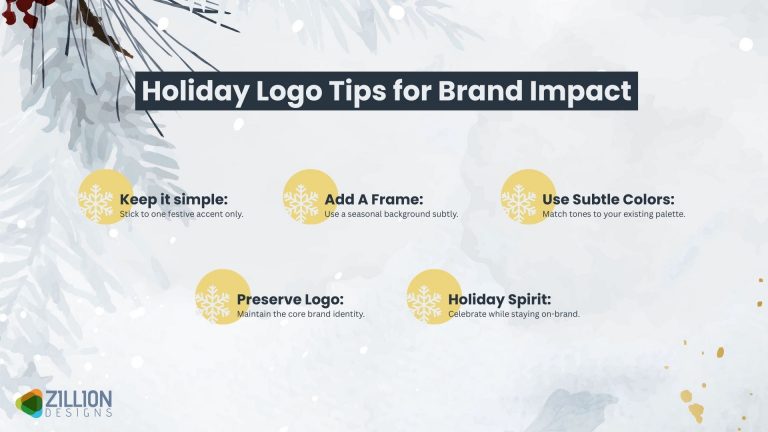Branding may not come to mind immediately when you think of nonprofit organizations, social enterprises, or any other organization whose mission is to provide social impact.
There is a common misconception that “branding” is exclusively associated with businesses and profit corporations. Now this might be partially correct. If you think about it, brand elements like nonprofit logos, website colors, and tone of voice are as important to organizations or associations as they are to corporations.
The purpose of non-profits may be different from that of for-profits, but many brand strategies are relevant to both. It is important to distinguish your nonprofit organization from others in the sector and cultivate relationships with your audience to nurture loyalty and trust. You can increase social awareness, raise more funds, and build a strong reputation over time by building a strong nonprofit brand.
Image Source: ZillionDesigns.com
Image Source: ZillionDesigns.com
Well, this is just a brief introduction. Let’s discuss in discuss how to promote your non-profit organization and what important tips you should follow.
Why is Non-Profit Branding Important?
Here are some reasons to know why branding is important for non-profit organizations:
1. Differentiating Yourself
You need the brand elements for your nonprofit to stand out among similar organizations and convey your message effectively. So think of distinct association logos or fundraising logos that evoke an emotional response among potential donors.
It has become increasingly difficult for nonprofits to distinguish themselves from other similar organizations that work on similar issues. An organization’s brand can play a crucial role in helping it become memorable to its customers. You will need a solid branding package if you want to make sure that your brand is unique and consistent at the same time.
You can include a range of elements in your brand package such as your organization’s name, logo, tagline, color scheme, font, website design, and others. The more cohesive and consistent all of these elements are, the better the chances of people remembering your nonprofit and your brand in the future.
2. Develop A Higher Level of Trust and Loyalty
Brands that have been carefully crafted, positioned, and aligned to their target audiences will gain the trust and loyalty of their target audiences. Strong nonprofit branding not only improves recognition among supporters but also helps to draw attention to your message. For instance, a professionally designed website that features your non-profit’s brand colors will earn the trust of audiences easily.
Image Source: dribbble.com/Jiya Shrestha
3. Increased Engagement and Fundraising
There is a high level of competition for funding in the nonprofit sector. The development of a strong nonprofit brand can increase visibility and generate support for your fundraising efforts. It also makes it easier to increase engagement among supporters and donors when a brand is strong.
The effectiveness of nonprofit branding goes beyond these simple things; it boosts internal cohesion, provides awareness of your cause and your work, and builds your organization’s reputation as well.
Non-Profit Branding: 7 Key Steps
Branding for nonprofits goes beyond color schemes and logo designs. It is a full vision of what your brand represents, and it should immediately come to mind when your name is mentioned or when your organization’s visuals are seen. Here are some key steps to creating a brand strategy to promote your nonprofit.
1. Create a Brief with Your Mission and Values
You should know what your organization stands for before deciding anything else about your brand. The rest of your branding decisions will be guided by your mission and values.
Defining your brand’s mission and values before making any other decisions is beneficial in many ways:
Rather than making your brand secondary to your organization’s mission and values, you can develop your branding decisions based on those values.
As a result, your organization will be given a clear direction and other branding decisions will be easier to make.
As a result, your organization is more likely to stand out in your local community by focusing on what a positive impact you have on it.
By using the Golden Circle Theory, your organization can highlight its mission and values. A successful brand starts by identifying the reason for its existence, according to the theory. Next, they determine how they will achieve their goals. The final step is to determine what kind of products or services they provide.
A former Harry Potter Alliance group, Fandom Forward has rebranded itself as Fandom Forward. Using the Golden Circle Theory, they explain briefly their mission on their About page.
The homepage of Fandom Forward provides an insight into what the organization is all about. You can identify their ‘why’ on their About page: “to make the world a more loving and fair place.”
In the following section, they explain how they make activism accessible to people around the world by harnessing popular fandoms. Finally, their What We Do section describes the actual mission of the organization. Having a separate section for the “what,” Fandom Forward can be more expansive in terms of the types of social goods they provide.
Fandom Forward uses this simple formula as a means of communicating the organization’s goals.
Image Source: fandomforward.org
2. Decide on Your Brand Visuals
The next step after deciding on your brand’s mission and values is to establish its visual identity. Visuals can be an effective way to catch your audience’s attention, depending on the channel and the audience.
You may wish to consider creating an infographic to convey your impact visually without the audience having to read a lot of text. People are looking for something short and simple on social media; this is what catches their attention and what catches their attention. If they are interested in learning more, you can provide links that will take them to additional information.
Consider the following visuals:
Logo of your brand
Your choice of font(s)
Colors
Name of your brand
After you identify your mission and values, use them as a graphic design style guide when creating your brand’s visuals.
Among the most established nonprofit foundations in Canada, the Catherine Donnelly Foundation is one of the largest. Among the social initiatives that they support are those concerning the environment, housing, adult education, and impact investments.
Taking advantage of the digital era with a redesigned brand, the Catherine Donnelly Foundation has adopted a modernized, human-centered approach.
As seen in the above example, the updated logo incorporates the “luminous C” symbolizing hope and light and relating to CDF’s initial.
Image Source: catherinedonnellyfoundation.org
3. Choose a Voice For Your Brand
What is the best way to communicate with members of your community? Are you trying to portray yourself as a caring friend? An adoring grandmother? A mentor?
So far, you’ve thought about how to communicate. When you determine your brand voice, you can explore how you communicate with your audience.
It is your voice that gives your brand its personality. As a result, your organization can set itself apart from similar organizations. When communicating with your community, whether in person, via telephone, through social media, or by email, this is what you should keep in mind.
When you understand your voice, you’ll be able to determine:
How to describe events using adjectives
No matter whether emojis or memes are used
How you would like your content to be read
Direct or indirect communication with readers
Citation types for your content
The strong brand voice of nonprofits that consistently maintain good branding will be evident to you.
The North York Women’s Shelter (or NYWS) offers emergency shelter and support to women throughout the Greater Toronto Area to help end violence against women. Their brand voice has evolved continuously and provides an excellent model for similar organizations that provide trauma-informed care.
While NYWS strives to maintain a positive brand, they do not lose sight of the importance and sensitivity of the services they provide. With a vibrant and encouraging color scheme and the use of illustrations, the team ensures a safe and reassuring environment, while remaining flexible enough to speak persuasively.
Image Source: nyws.ca
Image Source: nyws.ca
4. Appeal to the Emotions
It is possible to break through the inactivity and lack of interest of your supporters by using the emotions that drive them.
Having an emotional appeal is a good way to motivate people to take action as a nonprofit. Speak to your audience’s hearts as well as their minds to establish a meaningful emotional connection.
You could use stories or testimonials that demonstrate how your organization is changing lives, make people laugh with entertaining videos, or find creative ways to acknowledge the people and groups that contributed to your cause.
You will achieve greater impact and show the power of your work when your organization speaks to people’s emotions.
Founded in 2003, Project Home Again aims to provide furniture and household items free of charge to those in need.
Despite this nonprofit’s great mission, its strong brand voice makes it stand out in the crowd. Using TikTok’s video feature, they show how they put items together for families, narrated by an energetic woman who speaks with respect for these families.
They also leverage storytelling to create social media campaigns on other platforms. Emphasis is placed on the emotions of those who require their supplies as well as gratitude for those who provide them. It fits well with the values of respect and dignity that are at the core of their organization.
Image Source: phama.org
5. Tell a Story with Testimonials
There is a story behind every nonprofit organization. You can make your nonprofit stand out from the crowd by telling a compelling story.
The power of testimonials lies in their ability to convey your brand’s message effectively. A testimonial provides a first-hand account of the impact your brand has on the community.
Child’s Play Charity’s real-world impact on the community is shown in this testimonial. It is evident from this single sentence that Child’s Play Charity is committed to making hospital stays more enjoyable and less stressful.
Image Source: childsplaycharity.org
Although some nonprofits have no trouble collecting testimonials, for others, testimonials may not be an appropriate means of telling your organization’s story.
With social media platforms, nonprofit organizations have the opportunity to tell their own stories. Short videos provide an immediate sense of intimacy and authenticity, which may foster a sense of trust between you and your audience. Instagram Reels, TikTok, and YouTube shorts can be used to tell people how your nonprofit is making a difference.
Nonprofits can also utilize infographics as another opportunity to display their impact on the community, especially if the organization has been around for some time.
Regardless of how you choose to tell your story, you must do so well and often. In essence, your brand’s story is its “why”. This is the most effective way to motivate your community to participate in your cause and take action.
6. Clarify Brand Values in Communication
Be clear about the values you wish to promote in external and internal communication with employees or stakeholders.
For example, identify what types of images you like to see, along with any filters you regularly apply to your social media posts, and use them consistently.
Make sure your brand guide addresses common questions, such as whether marketers are allowed to incorporate memes or emojis into their work. This needs to be followed across all communication so it’s easier for people to associate certain traits and values with the nonprofit.
You want your brand’s information to be sufficiently descriptive, yet concise enough for the customer to become familiar with it quickly and easily.
Update stakeholders regularly and include visual elements in email newsletters, social media posts, and marketing collateral. This ensures that your audience feels the same level of personal connection regardless of how many people are on your marketing team.
7. Promote with Consistency
People should be able to recognize and connect your nonprofit brand to your organization, or any brand for that matter.
Having a strong brand identity ensures that the hard work you have put into developing it does not go unnoticed. Having a familiar brand makes your nonprofit’s mission more memorable to supporters. A solid, personable identity will connect your organization with supporters and support your other marketing efforts.
Image Source: weareloop.com
Your nonprofit’s brand can be promoted in several ways, including:
Optimizing search engine performance. The majority of users learn about new brands and products through search engines, making this platform the most popular means of building brand awareness. In the Google Ad Grant program, nonprofit organizations could receive monthly Google Ad credits worth $10,000. Your nonprofit’s website could be the first result for a relevant keyword, allowing you to reach more current and potential donors.
Use case studies. The power of telling real stories can be invaluable when promoting a cause. Be sure to include your case studies or brand advocates in your branding efforts. By using visual storytelling to build a brand, audiences will be able to connect emotionally with the brand.
The Young Women’s Trust, for example, provides career coaching and resume services to young women in the United Kingdom and makes testimonials one of the most important features of the company’s website.
Audiences that are typically considered ‘hard to reach’ may be motivated to engage with nonprofits after hearing about the success of others. The fact that their money and time are making a positive difference can also have an impact on your supporters.
Create interactive content. Engage your supporters in social activities beyond requesting donations or volunteering. Using social media to ask questions and respond to supporter comments facilitates these connections. The more your supporters learn about your values, the more they’ll connect with your brand.
Engaging donors at multiple channels. Would you remember a brand if you only saw promotional emails? Most likely not. Don’t just sell your brand on Facebook; make sure you’re there on SMS messages, direct mail, and other channels as well.
Conclusion
When creating a nonprofit branding strategy, there are many aspects to consider. The branding of your nonprofit organization is what makes it unique. You should have a clear understanding of your target audience and the message that you are trying to convey to increase recognition for the brand.
This information can assist you in developing a strong brand for your nonprofit and ensuring that all those who produce materials in the name of your nonprofit follow the same guidelines.
The post How to Create a Brand Strategy to Promote Your Non-Profit Organization? appeared first on ZD Blog.



